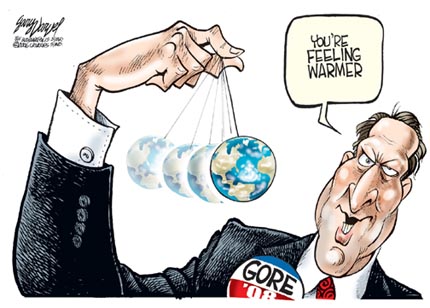
This article is based on a Heartland Panel talk [Dec7, 2015, at Hotel California, Paris].
The Intergovernmental Panel on Climate Change (IPCC) has to provide proof for significant human-caused climate change; yet their climate models have never been validated and are rapidly diverging from actual observations. The real threat to humanity comes not from any (trivial) greenhouse warming but from cooling periods creating food shortages and famines.
Burden of proof
Climate change has been going on for millions of years — long before humans existed on this planet. Obviously, the causes were all of natural origin and not anthropogenic. There is no reason to think that these natural causes have suddenly stopped. For example, volcanic eruptions, various types of solar influences, and atmosphere-ocean oscillations all continue today. We cannot model these natural climate-forcings precisely and therefore cannot anticipate what they will be in the future.
But let’s call this the “Null hypothesis.” Logically therefore, the burden of proof falls upon alarmists to demonstrate that this null hypothesis is not adequate to account for empirical climate data. In other words, alarmists must provide convincing observational evidence for anthropogenic climate change (ACC). They must do this by detailed comparison of the data with climate models. This is of course extremely difficult and virtually impossible since one cannot specify these natural influences precisely.
We’re not aware of such detailed comparisons, only of anecdotal evidence — although we must admit that ACC is plausible; after all, CO2 is a greenhouse gas and its level has been rising mainly because of the burning of fossil fuels.
Yet when we compare greenhouse models to past observations (“hindcasting”), it appears that ACC is much smaller than predicted by the models. There’s even a time interval of no significant warming (“pause” or “hiatus”) during the past 18 years or so — in spite of rapidly rising atmospheric CO2 levels.
There seems to be at present no generally accepted explanation for this discrepancy between models and observations, mainly during the 21st century. The five IPCC reports [1900 to 2014] insist that there is no “gap.” Yet strangely, as this gap grows larger and larger, their claimed certainty that there is no gap becomes ever greater. Successive IPCC reports give 50%, 66%, 90%, 95%, and 99% for this certainty.
Needless to say, there are no sufficient conditions to establish the existence of any significant ACC from existing data. Even necessary conditions based on empirical data, like temperature vs altitude and latitude, cloud cover, precipitation, are difficult to establish.
To summarize, any major disagreement of data with models therefore disproves ACC.
IPCC’s models are not validated — and therefore not policy-relevant
In other words, GH models have not been validated and may never be validated — and therefore are not policy-relevant.
Anyway, any warming observed during the past century appears to be trivially small and most likely economically beneficial overall. Careful studies by leading economists and agricultural experts have established these facts [see for example NIPCC-ClimateChangeReconsidered-II – 2014].
I therefore regard the absence of any significant GH warming as settled; note my emphasis on the word “significant.” Policies to limit CO2 emissions are wasting resources that could better be used for genuine societal problems like public health. They are also counter-productive since CO2 promotes plant growth and crop yields, as shown by dozens of agricultural publications.
Surviving a coming climate cooling
I am much more concerned by a cooling climate — as predicted by many climate scientists — with its adverse effects on ecology and severe consequences for humanity.
Singer and Avery in “Unstoppable Global Warming: Every 1500 years” have described one form of observed cyclical climate change. It was first seen during the past glaciation. Loehle and Singer claim evidence for these cycles to extend into the present.
In particular, historical records identify the recent cycle of a (beneficial) Medieval Warm Period (MWP) and the (destructive) Little Ice Age (LIA) with its failed harvests, starvation, disease, and mass deaths. Many solar experts predict another LIA cooling within decades.
I have therefore explored ways to counter the (imminent) next cooling phase through low-cost and low- ecological-risk geo-engineering, using a specific greenhouse effect – not based on CO2.
At the same time, assuming that our scheme does not work perfectly, we need to prepare for adaptation to a colder climate, with special attention to supply of food and sustainable water and energy.
The outlook for such adaptation appears promising – provided there is adequate preparation. However, the coming cold period will test the survivability of our technological civilization.
S. Fred Singer is professor emeritus at the University of Virginia and a founding director of the Science & Environmental Policy Project; in 2014, after 25 years, he stepped down as president of SEPP. His specialty is atmospheric and space physics. An expert in remote sensing and satellites, he served as the founding director of the US Weather Satellite Service and, more recently, as vice chair of the US National Advisory Committee on Oceans & Atmosphere. He is an elected Fellow of several scientific societies and a Senior Fellow of the Heartland Institute and the Independent Institute. He co-authored the NY Times best-seller Unstoppable Global Warming: Every 1500 years. In 2007, he founded and has chaired the NIPCC (Nongovernmental International Panel on Climate Change), which has released several scientific reports [See NIPCCreport.org]. For recent writings see http://www.americanthinker.com/s_fred_singer/ and also Google Scholar.
